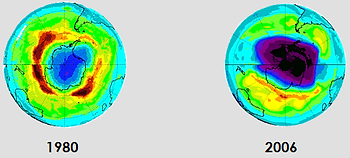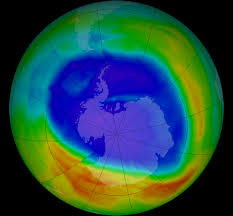Overview
September 1987: the United Nations made history. For the first time ever, universal ratification was achieved when all 197 countries signed the Montreal Protocol on Substances that Deplete the Ozone Layer. 30 years later, this treaty is still considered one of the most significant contributions to mitigating global climate change.
Simply known as the Montreal Protocol, this treaty was finalized when the importance of the ozone later was just starting to be understood. Designed to control the production and consumption of harmful substances, the treaty outlines phase-out plans that are still taking place today. Since its induction, the Protocol has undergone several updates to address additional substances in need of eradication.
The Ozone Layer
Protecting the planet from ultraviolet rays, the ozone layer acts as a shield that absorbs approximately 99% of the sun’s radiation. Without this shield we would be significantly more susceptible to skin cancer and blindness, plant life would quickly start deteriorating, and this would eventually lead to a carbon dioxide dominated atmosphere.
When the Montreal Protocol was signed, the hole in the ozone layer over the South Pole was 22.4 million square kilometers, a 20% increase from just eight years earlier. Since then, the size of the ozone hole has fluctuated, but steadily grew until reaching a peak (to date) in 2006 at 27 million square kilometers. It has since reduced to 21 million square kilometers.

Image Source: theozonehole.com
The Protocol
Put into force January 1st, 1989, the Montreal Protocol controls the production of harmful ODS. The original agreement addressed only CFCs and halons, but now includes a total of 165 substances. Using a phase-out process, timelines are assigned to each substance until they have been completely eliminated. A division is also made between developed and developing countries, where the former are given tighter timelines, while the latter have more time and can receive assistance through a Multilateral Fund.
The developments to the protocol come with continual advancements in ODS knowledge, the addition of climate change mitigation practices, and improved refrigeration technology. A great example is hydrofluorocarbons (HFCs) which were developed to replace CFCs and HCFCs. Though they do not deplete the ozone layer, HFCs are powerful greenhouse gases. In October of 2016 the UN added a phase-out of HFCs in an amendment to the Montreal Protocol. This amendment dictates a 10% reduction in HFCs by 2019, and an 85% reduction by 2036 for developed countries.
Success
The fact you can stand outside for more than five minutes without getting a sunburn is testament to the success of the Montreal Protocol. Tangible results are challenging to present, so trends are used to better analyse progress. The size of the ozone hole is the most obvious marker, showing a 6 million square kilometer reduction since it’s 2006 peak spread.Due to stringent regulatory control, manufacturing of ODS has been greatly reduced. For example, the aerosol industry reduced ODS use by nearly 50% in just three years; and the refrigeration sector dropped from 862,000 tonnes of ODS in 1986 to 302,000 tonnes in seven years (World Bank Group, 1998). As of 2017 Canadian “ODS consumption… has been reduced by almost 100%” (Gov of Canada).
Moving Forward
Seeking alternatives to ODS is an ongoing process with no one-size-fits-all solution. The World Bank recommends getting the latest information from the World Bank’s Global Environmental Coordination Division, and the Government of Canada updates their information and recommendations accordingly.
Anyone involved in refrigeration, agriculture, industrial cleaning, insulation, or any other application that may use ODS should be aware of which chemicals are being used and ensure they have the latest information on alternatives and regulations. It is only with global participation that we can fully eradicate these harmful substances.
All this progress because 30 years ago, the world decided that, as a global community and as species, the only solution to an inevitable global crisis affecting everyone would be to work together.” (Brigoriadis)
Did you know that refrigerants hold the NUMBER ONE spot for potential in reducing the impacts of climate change? Check out the book the Drawdown to learn more!
References
Brigoriadis, Elias, Thirty Years Later: How the Montreal Protocol Changed the World, The Link. 5 December 2017. <https://thelinknewspaper.ca/article/thirty-years-later-how-the-montreal-protocol-changed-the-world>
Leahy, Stephen, Without the Ozone Treaty You’d Get Sunburned in 5 Minutes, National Geographic. 25 September 2017. <https://news.nationalgeographic.com/2017/09/montreal-protocol-ozone-treaty-30-climate-change-hcfs-hfcs/>
The Montreal Protocol on Substances that Deplete the Ozone Layer, US Department of State. <https://www.state.gov/e/oes/eqt/chemicalpollution/83007.htm>
Cresswell-Turner, Max, What Would Happen to the Earth if the Ozone Layer Were Destoryed?, Quora. <https://www.quora.com/What-would-happen-to-the-Earth-if-the-ozone-layer-were-destroyed>
The Ozone Hole. <http://www.theozonehole.com/montreal.htm>
Government of Canada, Ozone Depletion: Montreal Protocol, 6 February 2016. <https://www.canada.ca/en/environment-climate-change/corporate/international-affairs/partnerships-organizations/ozone-depletion-montreal-protocol.html>
Government of Canada, Ozone Layer Depletion: Montreal Protocol, 10 August 2017. <https://www.canada.ca/en/environment-climate-change/corporate/international-affairs/partnerships-organizations/ozone-layer-depletion-montreal-convention.html>
Carlowicz, Michael, The World We Avoided by Protecting the Ozone Layer, Earth Observatory, 13 May 2009. <https://earthobservatory.nasa.gov/Features/WorldWithoutOzone/>
Multilateral Fund for the Implementation of the Montreal Protocol. <http://www.multilateralfund.org/default.aspx>
The World Bank, Ozone-Depleting Substances: Alternatives, July 1998. <https://www.ifc.org/wps/wcm/connect/4e730100488559478284d26a6515bb18/HandbookOzoneDepletingSubstancesAlternatives.pdf?MOD=AJPERES>
Government of Canada, Ozone-Depleting Substances and Halocarbon Alternatives Regulations, Updated 10 June 2016. <http://www.gazette.gc.ca/rp-pr/p2/2016/2016-06-29/html/sor-dors137-eng.html>
